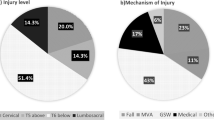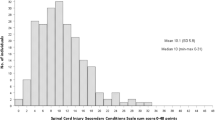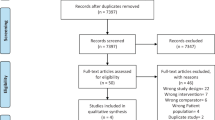Abstract
Study design
Cohort study.
Objectives
Shoulder pain prevalence is high in those with spinal cord injury (SCI) and is associated with decreased function, participation restrictions and decreased quality of life. Limited evidence exists regarding physical impairments of newly acquired SCI. The current study compared musculoskeletal factors at rehabilitation initiation in individuals with newly acquired SCI to uninjured individuals. We hypothesized no impairment differences of shoulder pain, strength, mobility, muscle extensibility, or rotator cuff integrity would exist between groups.
Setting
Multi-site laboratory setting.
Methods
Thirty-five individuals with newly acquired SCI and age and gender-matched controls without SCI (n = 34) participated. Musculoskeletal Pain Survey, shoulder range of motion (ROM), strength, pectoralis minor muscle extensibility (PM) and tissue integrity [Ultrasound Pathology Rating Scale (USPRS)] were obtained.
Results
Higher pain was reported by individuals experiencing new SCI along with lower strength across all bilateral measures, reduced elevation, external rotation, and horizontal adduction ROM, with large effect sizes. PM bilateral extensibility was reduced compared to controls, with moderate between group effect size; however, no USPRS score difference existed.
Conclusions
This study provided the first comprehensive clinical description for individuals with newly acquired SCI. In comparison to matched uninjured controls, participants with new SCI reported greater shoulder pain with impairments in mobility, strength, and extensibility. The identified early clinical impairments aligned with progressive impairment including further pain development and persistence. Awareness and modification of these early clinical impairments may lead to improved long-term outcomes, improving the overall health and well-being of individuals with newly acquired SCI.
Sponsorship
Spinal Cord Injury Research Program Investigator-Initiated Research Award under Award No. W81XWH-17-1-0476.
Similar content being viewed by others
Log in or create a free account to read this content
Gain free access to this article, as well as selected content from this journal and more on nature.com
or
Data availability
The authors confirm that the data supporting the findings of this study are available within the article.
References
National spinal cord injury statistical center, facts and figures at a glance. Birmingham: University of Alabama at Birmingham; 2019.
Hastings J, Robins H, Griffiths Y, Hamilton C. The differences in self-esteem, function, and participation between adults with low cervical motor tetraplegia who use power or manual wheelchairs. Arch Phys Med Rehabil 2011;92:1785–8.
Ballinger DA, Rintala DH, Hart KA. The relation of shoulder pain and range-of-motion problems to functional limitations, disability, and perceived health of men with spinal cord injury: a multifaceted longitudinal study. Arch Phys Med Rehabil 2000;81:1575–81.
McCasland LD, Budiman-Mak E, Weaver FM, Adams E, Miskevics S. Shoulder pain in the traumatically injured spinal cord patient: evaluation of risk factors and function. J Clin Rheumatol 2006;12:179–86.
Tate DG, Kalpakjian CZ, Forchheimer MB. Quality of life issues in individuals with spinal cord injury. Arch Phys Med Rehabil 2002;83(12 Suppl 2):S18–25.
Veeger HE, Meershoek LS, van der Woude LH, Langenhoff JM. Wrist motion in handrim wheelchair propulsion. J Rehabil Res Dev 1998;35:305–13.
Subbarao JV, Klopfstein J, Turpin R. Prevalence and impact of wrist and shoulder pain in patients with spinal cord injury. J Spinal Cord Med 1995;18:9–13.
Ambrosio F, Boninger ML, Souza AL, Fitzgerald SG, Koontz AM, Cooper RA. Biomechanics and strength of manual wheelchair users. J Spinal Cord Med 2005;28:407–14.
Boninger ML, Towers JD, Cooper RA, Dicianno BE, Munin MC. Shoulder imaging abnormalities in individuals with paraplegia. J Rehabil Res Dev 2001;38:401–8.
Mulroy SJ, Hatchett P, Eberly VJ, Lighthall Haubert L, Conners S, Requejo PS. Shoulder strength and physical activity predictors of shoulder pain in people with paraplegia from spinal injury: prospective cohort study. Phys Ther 2015;95:1027–38.
Eriks-Hoogland I, de Groot S, Snoek G, Stucki G, Post M, van der Woude L. Association of shoulder problems in persons with spinal cord injury at discharge from inpatient rehabilitation with activities and participation 5 years later. Arch Phys Med Rehabil 2016;97:84–91.
Eriks-Hoogland IE, Hoekstra T, de Groot S, Stucki G, Post MW, van der Woude LH. Trajectories of musculoskeletal shoulder pain after spinal cord injury: Identification and predictors. J Spinal Cord Med 2014;37:288–98.
van Drongelen S, de Groot S, Veeger HE, Angenot EL, Dallmeijer AJ, Post MW, et al. Upper extremity musculoskeletal pain during and after rehabilitation in wheelchair-using persons with a spinal cord injury. Spinal Cord 2006;44:152–9.
Teunis T, Lubberts B, Reilly BT, Ring D. A systematic review and pooled analysis of the prevalence of rotator cuff disease with increasing age. J Shoulder Elb Surg 2014;23:1913–21.
Neer CS 2nd. Impingement lesions. Clin Orthop Relat Res. 1983;173:70–7.
Kirshblum S, Waring W 3rd. Updates for the international standards for neurological classification of spinal cord injury. Phys Med Rehabil Clin N. Am 2014;25:505–17.
Hawkins RJ, Kennedy JC. Impingement syndrome in athletes. Am J Sports Med 1980;8:151–8.
Bennett WF. Specificity of the speed’s test: arthroscopic technique for evaluating the biceps tendon at the level of the bicipital groove. Arthroscopy 1998;14:789–96.
Hegedus EJ, Cook C, Lewis J, Wright A, Park JY. Combining orthopedic special tests to improve diagnosis of shoulder pathology. Phys Ther Sport 2015;16:87–92.
Clarnette RG, Miniaci A. Clinical exam of the shoulder. Med Sci Sports Exerc 1998;30:1–6.
Curtis KA, Roach KE, Applegate EB, Amar T, Benbow CS, Genecco TD, et al. Reliability and validity of the wheelchair user’s shoulder pain index (WUSPI). Paraplegia 1995;33:595–601.
Kendall F, McCreary E, Provance P, Rodgers M, Romani W. Muscles: Testing and function, with posture and pain. 5th ed. Baltimore: Lippincott, Williams & Wilkins; 2005.
Kolber MJ, Beekhuizen K, Cheng MS, Fiebert IM. The reliability of hand-held dynamometry in measuring isometric strength of the shoulder internal and external rotator musculature using a stabilization device. Physiother Theory Pract 2007;23:119–24.
Finley MA, Rodgers MM. Prevalence and identification of shoulder pathology in athletic and nonathletic wheelchair users with shoulder pain: a pilot study. J Rehabil Res Dev 2004;41(3B):395–402.
Kolber MJ, Hanney WJ. The reliability and concurrent validity of shoulder mobility measurements using a digital inclinometer and goniometer: a technical report. Int J Sports Phys Ther 2012;7:306–13.
Borstad JD. Measurement of pectoralis minor muscle length: Validation and clinical application. J Orthop Sports Phys Ther 2008;38:169–74.
Muraki T, Aoki M, Izumi T, Fujii M, Hidaka E, Miyamoto S. Lengthening of the pectoralis minor muscle during passive shoulder motions and stretching techniques: A cadaveric biomechanical study. Phys Ther 2009;89:333–41.
Finley M, Goodstadt N, Soler D, Somerville K, Friedman Z, Ebaugh D. Reliability and validity of active and passive pectoralis minor muscle length measures. Braz J Phys Ther 2017;21:212–8.
Weppler CH, Magnusson SP. Increasing muscle extensibility: a matter of increasing length or modifying sensation? Phys Ther 2010;90:438–49.
Naqvi GA, Jadaan M, Harrington P. Accuracy of ultrasonography and magnetic resonance imaging for detection of full thickness rotator cuff tears. Int J Shoulder Surg 2009;3:94–7.
Brose SW, Boninger ML, Fullerton B, McCann T, Collinger JL, Impink BG, et al. Shoulder ultrasound abnormalities, physical examination findings, and pain in manual wheelchair users with spinal cord injury. Arch Phys Med Rehabil 2008;89:2086–93.
Cohen J. Statistical power analysis for the behavioral sciences. 32nd ed. Hillsdale: Lawrence Erlbaum Associates; 1988.
Hasvold T, Johnsen R. Headache and neck or shoulder pain-frequent and disabling complaints in the general population. Scand J Prim Health Care 1993;11:219–24.
Pope DP, Croft PR, Pritchard CM, Silman AJ. Prevalence of shoulder pain in the community: the influence of case definition. Ann Rheum Dis 1997;56:308–12.
Van Harlinger W, Blalock L, Merritt JL. Upper limb strength: study providing normative data for a clinical handheld dynamometer. PM R 2015;7:135–40.
Mulroy SJ, Thompson L, Kemp B, Hatchett PP, Newsam CJ, Lupold DG, et al. Strengthening and optimal movements for painful shoulders (stomps) in chronic spinal cord injury: a randomized controlled trial. Phys Ther 2011;91:305–24.
Finley MA, Ebaugh D. Association of pectoralis minor muscle extensibility, shoulder mobility, and duration of manual wheelchair use. Arch Phys Med Rehabil 2017;98:2028–33.
Namdari S, Yagnik G, Ebaugh DD, Nagda S, Ramsey ML, Williams GR Jr. et al. Defining functional shoulder range of motion for activities of daily living. J Shoulder Elb Surg 2012;21:1177–83.
Requejo PS, Mulroy SJ, Haubert LL, Newsam CJ, Gronley JK, Perry J. Evidence-based strategies to preserve shoulder function in manual wheelchair users with spinal cord injury. Top Spinal Cord Inj Rehabil 2008;13:86–119.
Burnham RS, May L, Nelson E, Steadward R, Reid DC. Shoulder pain in wheelchair athletes. The role of muscle imbalance. Am J Sports Med 1993;21:238–42.
Curtis KA, Tyner TM, Zachary L, Lentell G, Brink D, Didyk T, et al. Effect of a standard exercise protocol on shoulder pain in long-term wheelchair users. Spinal Cord 1999;37:421–9.
Finley M, Ebaugh D, Trojian T. Agreement of musculoskeletal ultrasound and clinical assessment of shoulder impairment in manual wheelchair users with various duration of spinal cord injury. Arch Phys Med Rehabil 2018;99:615–22.
Collinger JL, Fullerton B, Impink BG, Koontz AM, Boninger ML. Validation of greyscale-based quantitative ultrasound in manual wheelchair users: relationship to established clinical measures of shoulder pathology. Am J Phys Med Rehabil 2010;89:390–400.
Funding
This work was supported by the Department of Defense, through the Spinal Cord Injury Research Program Investigator-Initiated Research Award under Award No. W81XWH-17-1-0476.
Trial registry
This trial is registered with ClinTrial.gov ID NCT03137394.
Author information
Authors and Affiliations
Corresponding author
Ethics declarations
Conflict of interest
The authors declare that they have no conflict of interest.
Additional information
Publisher’s note Springer Nature remains neutral with regard to jurisdictional claims in published maps and institutional affiliations.
Rights and permissions
About this article
Cite this article
Finley, M., Euiler, E., Trojian, T. et al. Shoulder impairment and pain of individuals with newly acquired spinal cord injury compared to uninjured peers. Spinal Cord Ser Cases 6, 68 (2020). https://doi.org/10.1038/s41394-020-0318-1
Received:
Revised:
Accepted:
Published:
DOI: https://doi.org/10.1038/s41394-020-0318-1
This article is cited by
-
Creating adapted environments: enhancing accessibility in virtual reality for upper limb rehabilitation through automated element adjustment
Virtual Reality (2025)
-
Relationship of psychosocial factors and musculoskeletal pain among individuals with newly acquired spinal cord injury
Spinal Cord Series and Cases (2021)



